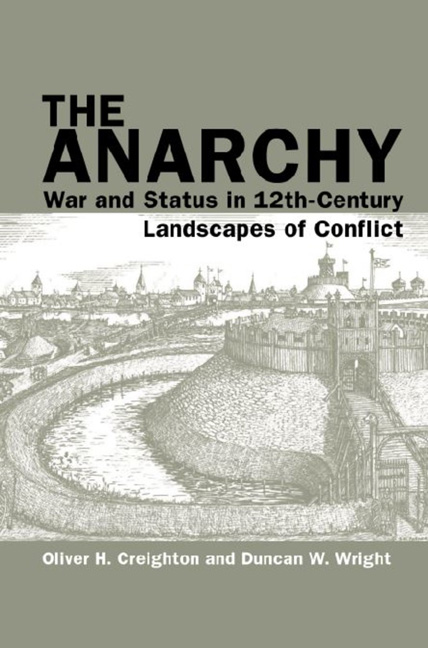Book contents
- Frontmatter
- Contents
- Acknowledgements
- List of Figures
- List of Colour Plates
- Chapter 1 Introduction
- Chapter 2 Historical Outline and the Geography of ‘Anarchy’
- Chapter 3 Waging War: Fields of Conflict and Siege Warfare
- Chapter 4 Architecture and Authority: Castles
- Chapter 5 Material Culture: From Arts to Coins
- Chapter 6 Performing Violence: Arms, Armour and Military Apparel
- Chapter 7 Faith and Fortification: The Church
- Chapter 8 Town, Village and Country
- Chapter 9 Anarchy on the Fen Edge: Case Study of the Isle of Ely
- Chapter 10 The Twelfth-Century Civil War in Context: Assessment and Reassessment
- Appendix Key Sites to Visit
- Bibliography
- Index
- Plate section
Chapter 1 - Introduction
- Frontmatter
- Contents
- Acknowledgements
- List of Figures
- List of Colour Plates
- Chapter 1 Introduction
- Chapter 2 Historical Outline and the Geography of ‘Anarchy’
- Chapter 3 Waging War: Fields of Conflict and Siege Warfare
- Chapter 4 Architecture and Authority: Castles
- Chapter 5 Material Culture: From Arts to Coins
- Chapter 6 Performing Violence: Arms, Armour and Military Apparel
- Chapter 7 Faith and Fortification: The Church
- Chapter 8 Town, Village and Country
- Chapter 9 Anarchy on the Fen Edge: Case Study of the Isle of Ely
- Chapter 10 The Twelfth-Century Civil War in Context: Assessment and Reassessment
- Appendix Key Sites to Visit
- Bibliography
- Index
- Plate section
Summary
THe War And Violence of human conflict, whether in the past or present, disturb, fascinate and remain enduringly popular topics of academic research. While the focus of this volume is an infamously destructive conflict which took place in twelfthcentury England, during the reign of King Stephen, the approach that it develops – wherein the psychological and symbolic aspects of warfare and its impacts on society are not divorced from the conventional military history of events on the ground – is more universally applicable. War was, and is, a cultural and social as well as a military phenomenon, and to study it in its totality it is essential to take account of the multiple arenas within which it was played out. The place of war is not necessarily the battlefield; equally, landscapes are more than just the setting for violence. The materialisation of warfare and militarised societies can comprise fortifications and other sites as well as artefacts and other forms of material culture and human remains. The impacts of conflict are always felt on social structures and human settlements across both the long and short term. Accordingly, this volume is intended as more than just an exploration of a particular conflict, but as a more detailed analysis of the interplay between war, society, material culture and landscape.
The troubled reign of Stephen, King of England (1135–54) has long held particular fascination for scholars of Anglo-Norman history. Stephen's protracted struggle with a rival claimant to the throne, the Empress Matilda, and her Angevin supporters saw England plunged into political turmoil, rebellion and bitter conflict for almost two decades. Contemporary writers reported with horror the activities of predatory lords responsible for a plague of castle building, damage to church property and devastation of the landscape, and since the late nineteenth century the conflict has been styled as ‘the Anarchy’ – although this term is now contentious. That the word ‘anarchy’ has since often been capitalised in the epithet ‘the Anarchy,’ puts it in a very select group of historical events including ‘the Conquest,’ ‘the Reformation’ and ‘the Dissolution,’ and has done much to elevate the period to prominence in the public consciousness.
- Type
- Chapter
- Information
- The AnarchyWar and Status in 12th-Century Landscapes of Conflict, pp. 1 - 12Publisher: Liverpool University PressPrint publication year: 2017

